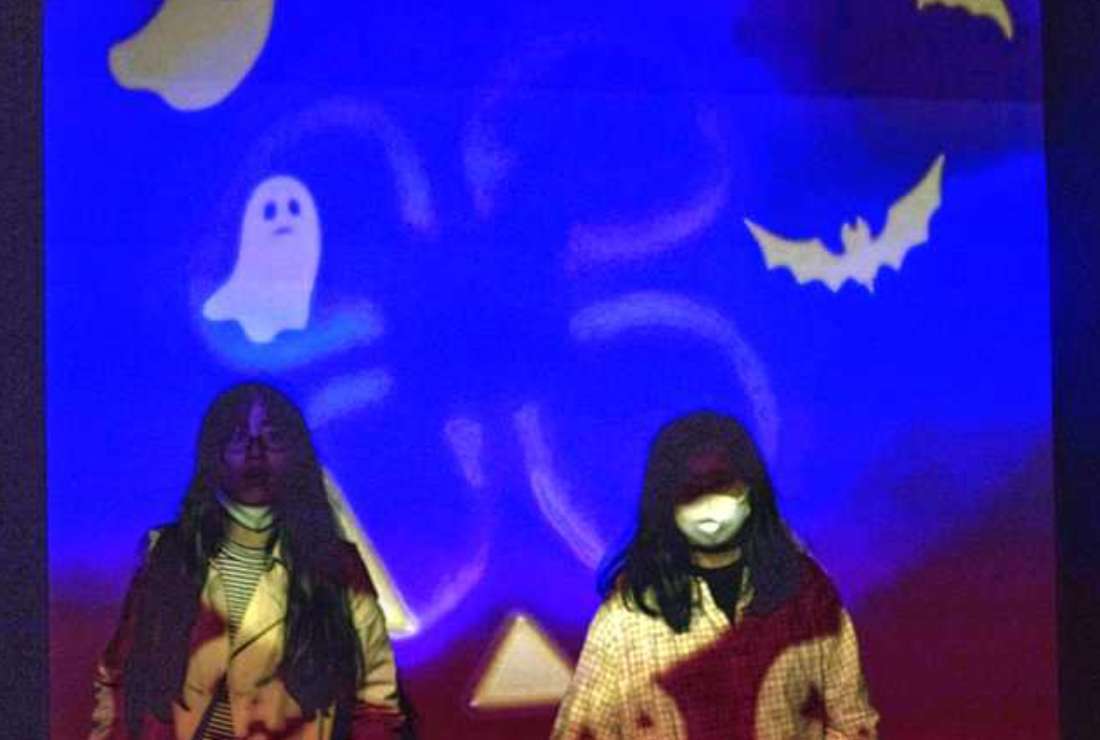

Visitors walk past a projection displaying Halloween ghosts and bats on a wall during a special Halloween exhibition at Sumida Aquarium in Tokyo on Oct. 29, 2020. (Photo: AFP)
In the West, fall is the time for ghosts and goblins (think Halloween); in Japan, summer is their season.
Both are uncomfortable times. Dying leaves and chilling gloom in Europe bring thoughts of death and demons. Japanese ghosts and “things that go bump in the night” apparently prefer the muggy nights of summertime.
Do the same ghosts spend part of the year rustling dead leaves in the West and part in the sweaty nights of Nippon?
I once asked, “Mommy, are there ghosts?” Mom’s answer was practical and left me agnostic on the question of the existence of ghosts: “Don’t worry about ghosts; it’s the living you should keep an eye on.”
People I have no reason to doubt have spoken of experiences that seem best explained by the presence of invisible beings with some sort of connection to a particular place. I have even had one such experience myself. Yet I remain agnostic.
But if there be ghosts we have the wrong picture of them when we fear them. The ghosts of Christmas Past, Present and Future in Charles Dickens’ A Christmas Carol desire to help Scrooge reform his life, not scare him to death.
Now I know that if I ever encounter a spectral ghost I must offer kindness to one in lonely pain, and maybe even give advice or permission to move on
Even better examples of what ghosts might be are found in the Harry Potter stories by J.K. Rowling.
Rowling’s ghosts are the not fully dead who fear to take the definitive step into the mystery of death. They fail to complete their life in this world and hang on to the shreds of an existence that is no longer real because it no longer involves growth or hope.
After years living in Tokyo and being as much a Tokyoite as a non-Japanese can be, I was assigned out of Japan, thinking I might never return. After a few years, I got back to the city for a quick visit.
As I walked once-familiar streets, I realized I no longer belonged there. The realization was so shattering that I slumped on the edge of a streetside flower tub, desolate. I was a ghost, someone who had once belonged but was no longer connected.
Eventually, I did return to Tokyo to live, so my ghosthood has been reversed, unlike ghosthood by death. Now I know that if I ever encounter a spectral ghost I must offer kindness to one in lonely pain, and maybe even give advice or permission to move on.
The mutually reinforcing effects of clerical abuse and cover-up, general irrelevance and pandemic have made many parishes ghosts of what they once were. Even where distancing is no longer required for Covid safety, there are many empty places in the pews. There is no reason to think those spaces will fill up soon. Growing ghosthood is the future of the Catholic Church in much of the world.
How can we respond to the Church becoming a ghost?
There is another way. It entails embracing ghosthood, accepting reality and not avoiding it. Yes, the Church as we have known it in much of the world is dying and no attempts at resuscitation will change that
Some may like the empty spaces in the community as a sign that only “the right kind of people” remain in the pews and the activities. But the thing about ghosts is that they hang around and haunt those who remain. Empty seats, empty coffers and empty activities will be like rattling chains as churches turn to houses haunted by the past.
Others “whistle past the graveyard,” making believe there really is nothing to worry about in spite of knowing the contrary: “It will all get back to normal sooner or later.” It will not.
Still, others join the ghosts, hanging on to the past like Rowling’s ghosts, fearful of the future to which God may be calling us. They would rather half-live than risk taking a flight that might end in a crash. So, they attempt to carry on, knowing that the ice sliding across the deck of their Titanic church is not from spilled drinks but resigned to what seems inevitable.
There is another way. It entails embracing ghosthood, accepting reality and not avoiding it. Yes, the Church as we have known it in much of the world is dying and no attempts at resuscitation will change that.
But for us Christians, this is an invitation to participate with the Holy Spirit in a new creation, a new beginning. Each year, we celebrate Good Friday as the beginning of new life. But we must get through the Holy Saturday of being dead before we reach the feast of the resurrection.
What if that were not simply a historical event or liturgical make-believe? What if, instead, what we mark in the Triduum were actually a pattern for the way that God brings about new life? What if the Church as we have known it must die in order to rise anew, and that attempts to deny, delay, remedy or ignore that put us in opposition to God’s work in the world?
If that be the case, to free the Church of ghosts we must embrace the real pattern of God’s relationship with us not in despair or paralyzed resignation but with joyful hope and even confidence that God is doing something new.
* The views expressed in this article are those of the author and do not necessarily reflect the official editorial position of UCA News.
Help keep UCA News independent
The Church in Asia needs objective and independent journalism to speak the truth about the Church and the state. With a network of professionally qualified journalists and editors across Asia, UCA News is just about meeting that need. But professionalism does not come cheap. We depend on you, our readers, to help maintain our independence and seek that truth. A small donation of US$2 a month would make a big difference in our quest to achieve our goal.